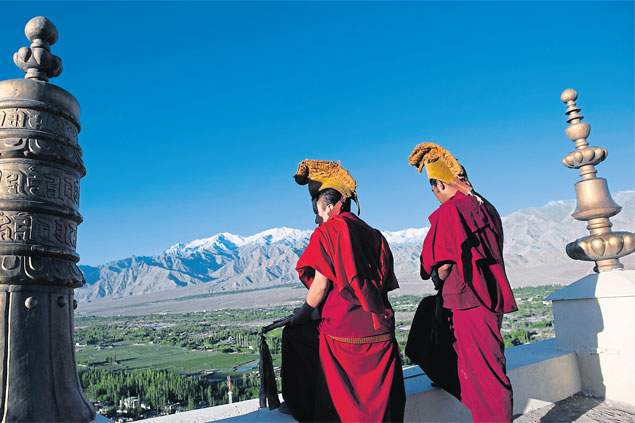
Life stands still in Ladakh's Buddhist monasteries. Prayers, monastic chores, fasting, more prayers and more fasting is pretty much how monks have lived their austere lives here for centuries. Trappings of technology such as mobile phones and Maggie (instant noodles) have trickled in but with no significant impact on their Spartan lives.
Living relics of a unique Tibetan Buddhist culture that harks back to the 11th century, these monasteries are repositories of Buddhist traditions and teachings as well as many important Buddhist artifacts such as the sacred thangkas that adorn the prayer halls.
Spiritual seekers, lay trekkers, anthropologists and curious hangers-on battle the thin Himalayan air and inhospitable terrain more than 3,500 metres above sea level to make it here for the famous morning prayers, where sonorous Buddhist chants reverberate in the ancient prayer halls.
But that is now about to change. While India may be bursting at the seams with a population of 1.25 billion, these monasteries that dot Ladakh's cold deserts are facing an acute shortage of monks. So dire is the situation that one day the 38 monasteries may become museum pieces with empty courtyards and silent prayer halls.

A five-year-old novice at the Hemis Monastery.
In this predominately Buddhist region of Jammu and Kashmir, each Buddhist family is traditionally enjoined by faith to give one of their sons to the monastery. This was followed to the letter until about a generation ago, back in the days when families had five children or more and the youngest could be easily sacrificed for the higher spiritual cause. With education and family planning, villagers now choose to have only one or two children with no one to spare for the monkhood.
To make matters worse, young lamas are choosing to drop out when they come of age, leaving the monasteries and the robes to marry, have children, till their ancestral land and lead a normal domestic life.
"If this goes on there will be no more monks in Ladakh. These monasteries will fall to ruin. The idea of family planning is not good for us. We need more children," says Jhamba, a senior monk at the Thiksey monastery. This is the message he regularly takes to the villages attached with his monastery.
Jhamba joins a long line of Indian religious leaders and celibates who, while having no children of their own, exhort couples to have more children. It was not too long ago that Sakshi Maharaj of the ruling Bhartiya Janta Party (BJP) was goading Hindus to have at least four children. Sadhvi Prachi, also from the BJP seconded him. Going further, the religious leader Shankaracharya of Badrikashram said Hindus should have at least 10 children.
Hindu religious leaders, of course, are responding to a demographic shift in India, where unverified studies point to a rapid upturn in Muslim numbers. According to these fears, fanned anxiously by the Hindu right, India will become a Muslim-majority state by 2035.
Ladakh's Buddhist monks, though, have no political agenda. They just want their monastic traditions to remain alive.
The monasteries were built by the various Buddhist dynasties that have ruled Ladakh for centuries. The white-walled buildings typically are clustered together on a hilltop from all sides, lending it an anthill appearance from far. Monasteries are places of seclusion but at the same time are intrinsically linked to nearby villages.

A monk chants in the prayer hall of the Hemis Monastery of the Drukpa sect of Tibetan Buddhism.
The Ladakhi villagers may not don monks' maroon robes but are equally religious. Tibetan prayer flags crisscross the villages, fluttering from every housetop and street. Telling the beads of the rosary or turning the prayer wheel are the favourite pastime here.
When the ceremonial bugle is blown from the monastery rooftop every morning, it is as much for the monks as for the villagers. All rites of passage including birth, death and marriage are presided over by monks. Some villages are many mountains away but devotees trek up to the monasteries to fetch a monk or two for the rituals.
The life of a monk is arduous and not something to which every boy growing up in Ladakh and exposed to modern comforts aspires. Monks young and old have to wake up with the morning bugle. After ablutions they head straight to the prayer hall. Monks no older than six years with sleep barely out of their eyes, join the rows in the halls for an hour of chanting.
These young initiates chant loudly, if only to keep themselves from dozing off, while the older monks keep a close watch. Serving butter tea to everyone including assembled visitors is a good distraction and they do the job enthusiastically, scurrying across the prayer hall. The same ritual is followed every morning without any change.
The young monks spend the day in the monastery school where the study of scriptures predominates. Games are tolerated but not encouraged. Food is usually the staple — a mixture of barley and flour kneaded to a dough and gulped down with butter tea.
But while the young monks still have a significant presence, there are far from enough of them to replace the old monks who pass on year after year.

Diversions for monks in Ladakh are limited but some do manage to get in a game of cricket.

Elderly monks at Thikse Monastery outnumber their younger peers, many of who are leaving the monkhood to raise small families. Few of the children of these young men are likely to don the robes in the future.

Matho Monastery is the only example in Ladakh of the Sakyapa sect of Tibetan Buddhism. It is home to a collection of thangkas dating back to the 14th century.

Food is plain and often shared from the same bowl.

Prayer flags flutter above the Thiksey Monastery near Leh.

At the Thikse Monastery and others it is the duty of the younger monks to serve tea and food to their older colleagues and visitors.